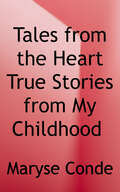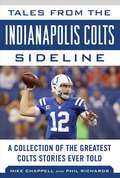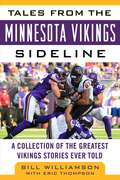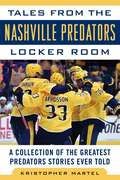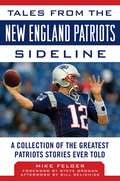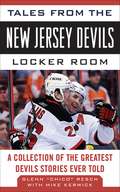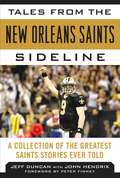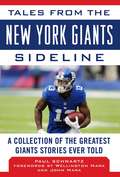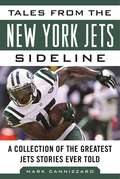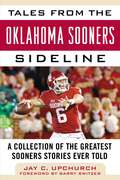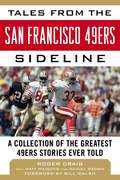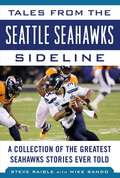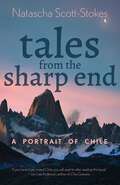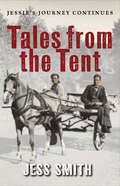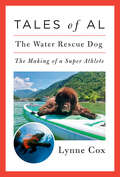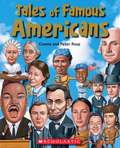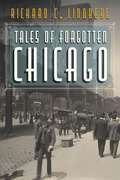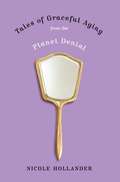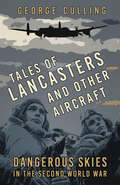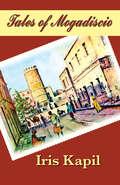- Table View
- List View
Tales from the Heart: True Stories From My Childhood
by Maryse CondéIn this collection of autobiographical essays, Maryse Conde vividly evokes the relationships and events that gave her childhood meaning: discovering her parents' feelings of alienation; her first crush; a falling out with her best friend; the death of her beloved grandmother; her first encounter with racism. <p><p>These gemlike vignettes capture the spirit of Conde's fiction: haunting, powerful, poignant, and leavened with a streak of humor. Maryse Conde's previous work includes the novels "Windward Heights "and "Desirada," both available from Soho Press.
Tales from the Indianapolis Colts Sideline: A Collection of the Greatest Colts Stories Ever Told (Tales from the Team)
by Mike Chappell Phil RichardsWith roots that go back to 1953, the Indianapolis Colts are one of the most storied franchises in the NFL. But the modern legacy of achievement began in 1984 when the Colts arrived in Indianapolis after a midnight escape from Baltimore. More than thirty years later, the Colts have forged an identity as one of the most dynamic, power-driven teams in football today.Now diehard Colts fans can relive all the struggles, all the passion, and all the glory of Indianapolis football in this newly revised edition of Tales from the Indianapolis Colts Sideline. Indiana sportswriters Mike Chappell and Phil Richards take readers inside the Colts’ Indiana Farm Bureau Football Center; onto the Lucas Oil Stadium sidelines; into the huddle; and inside the decisions, the strategies, the players, and the personalities that have made the Colts one of the NFL’s most exciting teams. They pay homage to Peyton Manning, Reggie Wayne, Dwight Freeney, and all the players who propelled the team to its Super Bowl victory following the 2006 season. And they look ahead as Andrew Luck and company attempt to bring home another title. This is the book for football fans that bleed Colts blue
Tales from the Minnesota Vikings Sideline: A Collection of the Greatest Vikings Stories Ever Told (Tales From The Team Ser.)
by Eric Thompson Bill WilliamsonTake a journey from the infant stages of football in Minnesota up through the Vikings’ four Super Bowl appearances in Bill Williamson and Eric Thompson’s Tales from the Minnesota Vikings Sideline. For more than fifty years the Vikings have established themselves as one of the premier teams in the NFL. Perhaps the most successful team to never win a Super Bowl, the Vikings have nevertheless harbored a rich tradition of winning football. Now fans of this Midwest powerhouse will relive all the history, all the passion, and all the tantalizingly glory of Vikings football within these pages. Remember the bone-chilling days of old Metropolitan Stadium? Or the no-nonsense, in-your-face coaching style of Bud Grant? From Cris Carter to Fran Tarkenton, Randy Moss, Brett Favre, Adrian Peterson, Teddy Bridgewater and more, this newly revised edition of Tales from the Minnesota Vikings Sideline has it all!
Tales from the Nashville Predators Locker Room: A Collection of the Greatest Predators Stories Ever Told (Tales from the Team #1)
by Kristopher MartelIn 1998, the Predators joined the NHL as an expansion team, marking the start of what’s been a wild ride ever since! Tales from the Nashville Predators Locker Room covers all the stories, from the adventures around the inaugural season, to Nashville’s storied rivalry against the Detroit Red Wings, road reports from players competing abroad during the 2004 lockout, the heartbreak of the 2010 playoff loss to the Chicago Blackhawks, the jubilation of winning a playoff series in 2011, the Matt Duchene offside goal controversy in 2013 that in turn helped to prompt official reviews, the art of the trade and how General Manager David Poile has helped land some of the biggest superstars on the roster, and of course the 2017 Stanley Cup Finals. In this insider’s account, the Predators’ greatest players and coaches—past and present—come to life. From P.K. Subban and Shea Weber, to Jason Arnott, Pekka Rinne, Filip Forsberg, Mike Fisher, and everyone in between, Fox Sports Tennessee correspondent Kristopher Martel covers it all. The perfect gift for any fan of Nashville hockey!
Tales from the National Press Club
by Gil KleinA behind-the-scenes history of the organization behind the White House Correspondents&’ Dinner—and the news-breakers and newsmakers who&’ve been part of it. Since the beginning of the twentieth century, the National Press Club has been the hub of Washington journalism. Started by reporters as a watering hole for late-night card games, the Club soon attracted not only icons from Edward R. Murrow to Bob Woodward to Helen Thomas, but every US president from Theodore Roosevelt onward, and various newsmakers who shaped American and world history. While adapting to changes in the news media, it continues to stand for the values of journalism and press freedom in the twenty-first century. Now journalist and longtime member Gil Klein tells just a few of the tales that stand out in the history of the Club, which CBS commentator Eric Sevareid once called &“the only hallowed place I know of that&’s absolutely bursting with irreverence.&”
Tales from the New England Patriots Sideline: A Collection of the Greatest Patriots Stories Ever Told (Tales From The Team Ser.)
by Mike Felger Bill BelichickThis revealing look at the New England Patriots captures the stories of passion, power, and struggles of one of the most remarkable franchises in sports. True Pats fans know that while today the team’s owner, coach, players, and stadium all rank among the best in the country, the early years weren’t so rosy. For decades the Patriots were a team known for having comically inept management and ownership, as well as the worst stadium in the NFL. It was only with the arrival of Coach Bill Belichick and quarterback Tom Brady in 2000 that the Pats became a powerhouse. In Tales from the New England Patriots Sideline, former players share the hilarious and shocking tales of the team’s early tumultuous years. Readers will walk through the tragedies and triumphs of Patriots history. As any true fan knows, to understand how far your team has come, you've got to know where they've been. Without a doubt, Tales from the New England Patriots Sideline is a must-read for any Patriots fan or Boston sports fanatic.
Tales from the New Jersey Devils Locker Room: A Collection of the Greatest Devils Stories Ever Told (Tales from the Team)
by Glenn Chico Resch Mike KerwickIn Tales from the New Jersey Devils Locker Room, former New Jersey goalie Chico Resch and coauthor Mike Kerwick bring readers along for a wild ride from the lean early seasons to the three Stanley Cup championships of this beloved team.
Tales from the New Orleans Saints Sideline: A Collection of the Greatest Saints Stories Ever Told (Tales From The Team Ser.)
by Duncan Jeff Finney PeterRelive the Greatest Moments in Saints Football—Newly Updated!The New Orleans Saints own a rich history that reflects the unique character of their hometown—always colorful, sometimes sinful, and utterly unpredictable. In recent years, the Saints have shaken off their reputation as the NFL’s lovable Fleur de Losers and have risen to become a dangerous gridiron competitor once again.Despite the struggles of their early years, the Saints are adored and worshipped by their fans like few other teams in the league. Their diehard followers are resilient, passionate, and eternally optimistic. In this newly revised edition of Tales from the New Orleans Saints Sideline, author Jeff Duncan chronicles the flamboyant history of the franchise, its highs and lows, the great coaches and players, and the colorful characters that have made it one of the most interesting clubs in NFL history. Tales from the New Orleans Saints Sideline details the franchise’s journey from the bumbling early years under freewheeling owner John Mecom, through the misguided and madcap three seasons under Coach Mike Ditka, and the return to respectability under the wise Sean Payton. Primed and ready to achieve the glory that has thus far eluded them, the New Orleans Saints have hundreds of stories to be told, and thousands of moments to share. Now fans will relive all the greatest triumphs and most devastating defeats, and get the inside story from former Saints greats like Mora, Archie Manning, Morten Andersen, Pat Swilling, Drew Brees, and more. Without a doubt, Tales from the New Orleans Saints Sideline is a must-have for any football fan.
Tales from the New York Giants Sideline: A Collection of the Greatest Giants Stories Ever Told (Tales from the Team)
by Wellington Mara Paul Schwartz John MaraFew sports franchises can match the long, stories history, rich tradition, and legion of passionate, loyal fans of the New York Giants. In this newly-updated edition of Tales from the New York Giants Sideline, memories, anecdotes, names, faces, games, cheers, and tears come rushing back, along with new twists to old fables and old remembrances revitalized with fresh insight.Learn about so many Giants players, including Frank Gifford, Y. A. Tittle, Lawrence Taylor, Eli Manning, and coach Bill Parcells. There is Phil Simms, nearly perfect in the biggest game of his life, Phil McConkey’s heart, David Tyree’s magic helmet, and Odell Beckham’s magic hands. Relive the Super Bowl victories in the 1980s, 1990s, 2000s, and 2010s. Experience the fearsome opponents, the feared defenses, the quarterbacks who could, and the ones who could not, with reminiscences bursting back to life in the words of the men who played the game.Tales from the New York Giants Sideline tells the inside story of one of the NFL’s most popular teams. This book is unquestionably a must-read for all fans of the Big Blue.
Tales from the New York Jets Sideline: A Collection of the Greatest Jets Stories Ever Told (Tales from the Team)
by Mark CannizzaroIdeal for fans of the Mark of a Lion series and Bill ParcellsPro football chronicle of the New York JetsCovers the successes and losses of the JetsFor over 55 seasons, the New York Jets have not enjoyed large doses of pride and glory. Yes, Joe Namath led them to a stunning Super Bowl III upset victory in 1968. But since then, the Jets have gone back and forth between maddening and entertaining, bumbling and embarrassing, and constantly teasing their fierce fan base. At this point, rather sadistically, the rollercoaster of rooting for the Jets has become a way of life. In Tales from the New York Jets Sideline, author Mark Cannizzaro brings his readers on a journey. Readers and author travel through Cannizzaro’s eyes and the eyes of the subjects he has covered, throughout the maze of musings, controversial coincidences, and the occasional brilliance that the Jets have displayed during the years the author has followed the franchise. This includes their consecutive AFC Championship Game losses in 2009 and 2010 and the following struggles, adding to the former angst and teases Jets fans have felt since Joe Willie’s memorable triumph. Skyhorse Publishing, as well as our Sports Publishing imprint, are proud to publish a broad range of books for readers interested in sports—books about baseball, pro football, college football, pro and college basketball, hockey, or soccer, we have a book about your sport or your team.Whether you are a New York Yankees fan or hail from Red Sox nation; whether you are a die-hard Green Bay Packers or Dallas Cowboys fan; whether you root for the Kentucky Wildcats, Louisville Cardinals, UCLA Bruins, or Kansas Jayhawks; whether you route for the Boston Bruins, Toronto Maple Leafs, Montreal Canadiens, or Los Angeles Kings; we have a book for you. While not every title we publish becomes a New York Times bestseller or a national bestseller, we are committed to publishing books on subjects that are sometimes overlooked by other publishers and to authors whose work might not otherwise find a home.
Tales from the New York Rangers Locker Room: A Collection of the Greatest Rangers Stories Ever Told (Tales from the Team)
by Mike Shalin Gilles Villemure Ed GiacominIn the late 1960s the New York Rangers transformed from NHL also-rans to Stanley Cup contenders. Gilles Villemure was part of that transformation. The little goaltender had a long wait to make it to the National Hockey League, which had only six teams until after the middle of the decade. Eventually Villemure joined Eddie Giacomin to give the Rangers a strong 1-2 goaltending tandem. The Vezina Trophy-winning twosome was a fixture for the Rangers, threatening to end the franchise’s long Stanley Cup drought, only to come up short. Now, forty years later, Villemure writes about his days with the Rangers in the newly updated Tales from the Rangers Locker Room. Villemure tells stories about old pals like Rod Gilbert, Vic Hadfield, Brad Park, Jean Ratelle-and his boss, Emile "The Cat” Francis.The Rangers finally won that Stanley Cup in 1994, ending over fifty years of frustration, but it was those Francis-led teams-the ones with Villemure and Giacomin in the goal-that brought New York’s Blueshirts, Madison Square Garden’s finest, to the top of the NHL. It is their influence that has continued to propel the Rangers forward even today, with a conference championship win in 2014 and the President’s Trophy in 2015. Fans young and old will want to hear Villemure’s stories come to life.Skyhorse Publishing, as well as our Sports Publishing imprint, are proud to publish a broad range of books for readers interested in sports-books about baseball, pro football, college football, pro and college basketball, hockey, or soccer, we have a book about your sport or your team.Whether you are a New York Yankees fan or hail from Red Sox nation; whether you are a die-hard Green Bay Packers or Dallas Cowboys fan; whether you root for the Kentucky Wildcats, Louisville Cardinals, UCLA Bruins, or Kansas Jayhawks; whether you route for the Boston Bruins, Toronto Maple Leafs, Montreal Canadiens, or Los Angeles Kings; we have a book for you. While not every title we publish becomes a New York Times bestseller or a national bestseller, we are committed to publishing books on subjects that are sometimes overlooked by other publishers and to authors whose work might not otherwise find a home.
Tales from the Oakland Raiders Sideline: A Collection of the Greatest Raiders Stories Ever Told (Tales from the Team)
by Matt Fulks Tom Flores Jim PlunkettIt’s almost impossible to talk about Oakland football without bringing up the name of the consummate Raider, Tom Flores. Legendary for both his skills on the field and his coaching guidance from the sideline, Flores has been an integral part of the Raiders organization since its inception in 1960. Now Flores shares the greatest stories and anecdotes from his time with the team in the newly updated edition of Tales from the Oakland Raiders Sideline. Flores relives the heart-stopping thrills and adrenaline-surging passion of Super Bowl XV and Super Bowl XVIII, and provides behind-the-scenes humor from greats such as former coach and owner Al Davis and coach Eddie Erdelatz. Flores also shares tales of other Raiders greats such as Billy Cannon, Jim Otto, John Matuszak, Bo Jackson, and more. Without a doubt this is a must-have for any Raiders fan.
Tales from the Oklahoma Sooners Sideline: A Collection of the Greatest Sooners Stories Ever Told (Tales from the Team)
by Jay C. UpchurchNo single element or ingredient has the power to absolutely define the lasting enchantment of Oklahoma football. Decades of great successes and occasional heartbreak have spawned generations of faithful disciples, who treat fall Saturdays like sacred holidays dedicated to their heroes donning the crimson and cream. Tales from the Oklahoma Sooners Sideline offers these fans a glimpse, often with a behind-the-scenes perspective, into the tradition surrounding Oklahoma football. Dozens of stories and details describe the individual and team triumphs that commenced with the hiring of legendary coach Bud Wilkinson and continue today. This newly revised edition of Tales from the Oklahoma Sooners Sideline captures the stories from OU greats such as Pop Ivy, Bud Wilkinson, Tommy McDonald, Eddie Crowder, Billy Vessels, Prentice Gautt, Joe Don Looney, Granville Liggins, Steve Owens, Barry Switzer, Greg Pruitt, the Selmon brothers, Billy Sims, Joe Washington, Brian Bosworth, Keith Jackson, Thomas Lott, Bob Stoops, Roy Williams, Josh Heupel, Rocky Calmus, Adrian Peterson, Sam Bradford, Baker Mayfield, and many, many more. This treasure trove of history, anecdotes, and stats is sure to satisfy any Sooners fan.
Tales from the Philadelphia Eagles Sideline: A Collection of the Greatest Eagles Stories Ever Told (Tales from the Team)
by Gordon ForbesEven in their worst of seasons, the Philadelphia Eagles maintained their tradition of toughness, thanks to great players—legends like Chuck Bednarik and Steve Van Buren to more recent heroes such as Reggie White and Donovan McNabb. In this newly updated edition of Tales from the Philadelphia Eagles Sideline, veteran football writer Gordon Forbes profiles the individuals who have thrilled Philadelphia fans since the team’s inception in 1933 through Doug Pedersen’s contenders of today, With all the wit and skill that comes from over forty years in the sports reporting business, Forbes details the championships, the losses, and the hard-knocking style of the Philadelphia Eagles.The great players and some of the not-so-great characters are recalled in the form of flashbacks to another time in Tales from the Philadelphia Eagles, Without a doubt, this book is a must-have for anyone who has ever cheered for the Eagles.
Tales from the San Francisco 49ers Sideline: A Collection of the Greatest 49ers Stories Ever Told (Tales From The Team Ser.)
by Matt Maiocco Roger CraigThe San Francisco 49ers shaped the NFL throughout the 1980s with their unique blend of precision, panache, and preparation. Three decades later, NFL teams are still copying the system and the methods that made the 49ers unlike any other organization in professional sports. Now fans of this dynamic franchise will relive all the action and thrills of 49ers football through the eyes of one of the greatest San Francisco legends of all time: Roger Craig.Star of three of the 49ers Super Bowl wins, Roger Craig was one of the most productive players in franchise history. The first player in NFL history to top 1,000 yards rushing and receiving in the same season, he used his knee-churning, eyes-wide-open style to earn four trips to the Pro Bowl and score a Super Bowl–record three touchdowns in one game. In this newly revised edition of Tales from the San Francisco 49ers Sideline, Roger Craig uses his trademark vision to capture some of the moments that defined the organization during its glory years, and up the present day. Included are stories about all of the men who shaped the direction of the franchise, including such luminaries as Bill Walsh, Joe Montana, Steve Young, Ronnie Lott, Jerry Rice, George Seifert, and more. Fans will relive all the great moments and read some never-before-told stories from a man who kept his eyes open to everything during his fascinating career.
Tales from the Seattle Seahawks Sideline: A Collection of the Greatest Seahawks Stories Ever Told (Tales from the Team)
by Mike Sando Steve RaibleFrom the hilarious to the surreal, from inside the huddle to inside the broadcast booth, twenty-eight-year Seattle Seahawks veteran Steve Raible takes fans to places they never knew existed. In this newly revised edition of Tales from the Seattle Seahawks Sideline, fans are offered an inside look at life in the locker room and on the sidelines of one of the NFL’s most beloved franchises. Readers will have the chance to laugh along as Jack Patera trades Andre Hines to the Dolphins after warning Don Shula that a worse offensive lineman never existed, to marvel as Raiders legend John Matuszak becomes Seattle’s offensive coordinator during the final minutes of the Seahawks’ blowout win, to come along with Steve Largent as the Hall of Famer obliterates Broncos safety Mike Harden in the ultimate payback, and so much more.This book brings all the Seahawks’ greatest players to life from Jim Zorn, to Dave Krieg, Kenny Easley, Curt Warner, Brian Bosworth, Cortez Kennedy, Warren Moon, Mike Holmgren, Ricky Watters, Chad Brown, Shaun Alexander, and more. This insider’s account also explores the lesser known characters whose stories inspire laughter, tears, and lasting lessons. Tales from the Seattle Seahawks Sideline is all about the people, proving through vivid anecdotes why the Seahawks are one of the most storied franchises in today’s NFL.
Tales from the Sharp End: A Portrait of Chile
by Natascha Scott-StokesTales from the Sharp End: A Portrait of Chile is based on fifteen years of Natascha Scott-Stokes living and exploring the country of Chile. The book offers a vivid tapestry of stories ranging from history and culture to flora and fauna, woven into the author’s own tales of adventure and heartbreak.Chile is 4,300 kilometers long but a mere 350 kilometers at its widest, lined by the Andes to the east and the Pacific to the west. Traveling along the Pan-American Highway takes you to both the driest desert on earth and impenetrable cloud forests barring the way to Patagonian ice fields. Here is the true magnet of this jagged knife-edge of a country: the unique landscape born of its geography and the gorgeous plant and animal life there. Few things are more thrilling than climbing the coastal mountains to see both the Andes and the ocean at the same time, or to set eyes on the mighty River Baker churning through southern Patagonia.Natascha Scott-Stokes offers both a love letter to Chile and a heartfelt lament for a country living at the sharp end of human folly and climate change.
Tales from the Tent: Jessie's Journey Continues
by Jess SmithFrom the author of Jessie&’s Journey, a memoir of finding her own way in the world after growing up in a family of Scottish travellers. As Tales from the Tent begins, Jess Smith has left school, and after a miserable spell working in a paper mill, she abandons the settled life and takes to the roads once more. The old bus she lived in as a child has gone, to be replaced by a caravan and campsites. Times are changing, and it is becoming harder and harder for travellers to make a living by doing the rounds of seasonal jobs like berry-picking. Conscious that the old way of life was disappearing before her eyes, Jess stored up as much as she could gather from the rich folklore of the travellers&’ world. Now she retells some of the many stories and songs she heard by the campfire or at the tent&’s mouth. Interwoven with these tales is the story of Jess and her life on the road—her first loves, her friendships, her days hawking and berry-picking, the exploits of her lovable but infuriating family, and the unforgettable characters she meets.Praise for the trilogy: &“Skillfully takes her reader into the world of Scottish Travellers in her own down-to-earth, straight-from-the-heart manner.&” —Travellers' Times &“Heartwarming reminiscences.&” —Sunday Post
Tales of Al: The Water Rescue Dog
by Lynne CoxThe moving, inspiring story of Al, the ungainly, unruly, irresistible Newfoundland puppy who grows up to become a daring rescue dog and super athlete—part of Italy's elite, highly specialized corps of water rescue dogs who swoop out of helicopters and save lives.Lynne Cox—acclaimed best-selling author of Swimming to Antarctica—is internationally famous for swimming the world&’s most difficult waterways without a wet suit, and able to endure water temperatures so cold that they would kill anyone else, recognizes and celebrates all forms of athleticism in others, human or otherwise. And when she saw a video of a Newfoundland dog leaping from an airborne helicopter into Italian waters to save someone from drowning, Cox was transfixed by the rescue, and captivated by the magnificence, physicality, and daring of the dog. Tales of Al is the moving, inspiring story of Cox&’s adventures on Italy&’s picturesque Lake Idroscalo, as witness to the rigorous training of one of these spectacular dogs at SICS, the famed school that has taught hundreds of dog owners how to train their dogs—Newfoundlands, German shepherds, and golden retrievers—for this rescue operation. Cox writes about coming to know the dog at the book&’s center, Al herself, from puppyhood, an adorable but untrainable chocolate Newfoundland—about the dreams, expectations, disappointments, and vision of her trainer and about realizing the dog&’s full potential; striving with all of her canine might to become an expertly trained, highly specialized water rescue dog.
Tales of Aztlan, The Romance of a Hero of Our Late Spanish-American War, Incidents of Interest from the Life of a Western Pioneer and Other Tales
by George HartmannTales of Famous Americans
by Peter Roop Connie RoopA perfect introduction to some of the people who built, changed, and challenged the U.S.A., Tales of Famous Americans will delight young readers. Thrilling childhood stories about people from Pocahontas and Ben Franklin to Yo-Yo Ma and Mia Hamm lead into exciting accounts of their incredible accomplishments as adults. With lively art and lots of fun facts, this book is sure to inspire the next generation of famous Americans!
Tales of Forgotten Chicago
by Richard C. LindbergContains twenty-one fascinating, little-known stories about Chicago and its people. Spanning the Civil War through the 1960s, the volume showcases forgotten crimes, punishments, and consequences: poisoned soup that nearly killed three hundred leading citizens; a woman in showbiz and her street-thug husband whose checkered lives inspired a 1955 James Cagney movie; and the first police woman in Chicago, hired as a result of the senseless killing of a young factory girl in a racially tinged case of the 1880s. Also included are tales of industry and invention, such as America's first automobile race, the haunting of a wealthy Gilded Age manufacturer's mansion, and the identity of the telephone's rightful inventor. Chapters on the history of early city landmarks spotlight the fitht to save Lakefront Park and how "Lucky" Charlie Weeghman's northside baseball park became Wrigley Field. Other chapters explore civic, cultural, and political happenings, and some are just wonderful tales, such as a touching story about the sinking of Chicago's beloved Christmas tree ship. The final story describes the start of the Special Olympics which began in Chicago. RICHARD C. LINDBERG is an award-winning author, journalist, and lecturer who has written nineteen other books about Chicago history, politics, criminal justice, sports, and ethnicity. The 2011 memoir of his Northwest Side boyhood Whiskey Breakfast: My Swedish Family, My American Life, was named nonfiction book of the year by the Chicago Writer's Association.
Tales of Graceful Aging from the Planet Denial
by Nicole HollanderOne of America’s funniest women asks, “If sixty is the new fifty, when do I get to be thirty again?”Nicole Hollander grew up in the nineteen-fifties, when women of a certain age put on weight, got a really tight perm, and rode the backs of their house slippers into the ground. Oh, for those uncomplicated good old days. Today, your fifties and sixties are deemed your most creative years—you can’t lie around like a slug unless you suddenly want to be seventy with nothing to show for it. Luckily, inTales...
Tales of Lancasters and Other Aircraft: Dangerous Skies in the Second World War
by George CullingOf every 100 operational airmen in World War Two, 9 were killed flying in England and 3 severely injured in crashes, so non-operational casualties were significant in numbers, over 15,000. Operational casualties were of course chillingly grim – over 56,000 airmen died in the Second World War, over half those involved. George Culling was a nineteen-year-old Lancaster navigator whose own experiences often involved battling tricky and dangerous conditions. Fascinated by the ever-present dangers for airmen even well away from combat, he has collated tales from comrades and combined them with his own to preserve some of the unexpected, inconvenient, dangerous, and often downright bizarre experiences that frequently typified daily life for airmen in the Second World War.
Tales of Mogadiscio
by Iris KapilMogadiscio was not always the sprawling jerry-built urban landscape we see today. Until 1991, when the government fell and clan militias, in a civil war, reduced it to rubble, Mogadiscio was a lovely, vibrant city. Tales of Mogadiscio describes a time, during the 1960s, when Mogadiscio was the capital and center of a newly independent Somali Republic. The stories portray individuals and the city's various communities. Mogadiscio is observed and reflected upon by the author, who lived among its people and loved the city.
